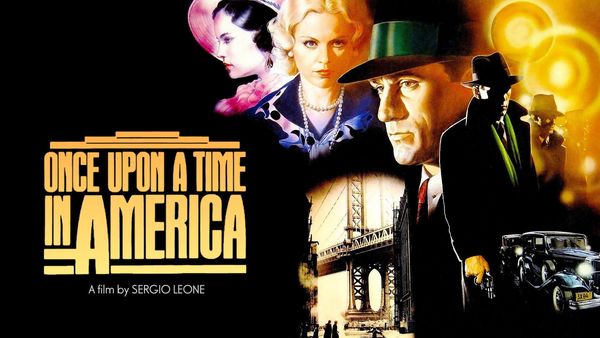Once Upon a Time in America (1984)

Once Upon a Time in America (1984), directed by Sergio Leone and starring Robert De Niro and James Woods, is an ambitious and sprawling epic that explores the complexities of friendship, crime, and the passage of time. The film, adapted from Harry Grey’s novel The Hoods, is often regarded as a masterpiece of the gangster genre and a profound meditation on the effects of time and memory. This essay provides a comprehensive analysis of Once Upon a Time in America, examining its narrative structure, character development, thematic elements, and cultural impact.

The narrative of Once Upon a Time in America is renowned for its non-linear structure, which weaves together multiple timelines to create a rich and layered story. The film spans several decades, depicting the rise and fall of a group of Jewish gangsters in New York City.
The story primarily follows Noodles (Robert De Niro) and his childhood friends, who rise from poverty to become influential figures in the criminal underworld. The plot unfolds through a series of flashbacks and present-day scenes, revealing the complex relationships between the characters and their individual journeys.
The film begins with Noodles’ return to New York after years in exile. He is haunted by memories of his past, and the narrative gradually reveals the events that led to his current state of isolation and regret. Through a series of flashbacks, viewers are introduced to Noodles’ early life, his rise in the criminal world, and the personal and professional conflicts that shaped his destiny.
Key events include Noodles’ involvement in organized crime, his tumultuous relationship with his friends and romantic interests, and his eventual downfall. The film also delves into the consequences of betrayal and the impact of choices made over a lifetime. The intricate plot demands attentive viewing, as the non-linear storytelling challenges audiences to piece together the fragmented narrative.

The characters in Once Upon a Time in America are deeply developed, with their personal stories and relationships forming the core of the film. The performances by the cast are integral to the film’s impact, with each actor bringing depth and complexity to their roles.
Noodles (Robert De Niro): De Niro’s portrayal of Noodles is central to the film. As the protagonist, Noodles’ journey from a hopeful young gangster to a disillusioned old man is portrayed with remarkable depth. De Niro captures Noodles’ internal struggles, regrets, and longing for redemption, conveying the character’s emotional evolution with subtlety and nuance.
Max (James Woods): Woods’ performance as Max, Noodles’ best friend and rival, adds a dynamic and volatile element to the film. Max’s charisma and ambition drive much of the plot’s conflict, and Woods effectively portrays his character’s charm and ruthlessness. The complex relationship between Noodles and Max, marked by friendship and betrayal, is one of the film’s most compelling aspects.
Other Key Characters: The supporting cast, including Elizabeth McGovern as Deborah, Joe Pesci as Frankie, and Treat Williams as Police Lieutenant, also contribute significantly to the film’s depth. McGovern’s portrayal of Deborah, Noodles’ love interest, adds a layer of personal and emotional conflict, while Pesci’s role as Frankie brings intensity and menace to the criminal activities depicted in the film.
Once Upon a Time in America explores several profound themes through its narrative and character development:
The Passage of Time: The film’s non-linear structure underscores the theme of time and its impact on individuals. The juxtaposition of past and present highlights the changes that occur over a lifetime, both in terms of personal growth and the consequences of choices. The passage of time is depicted as both a source of nostalgia and a reminder of lost opportunities.
Memory and Regret: The theme of memory is central to the film, with Noodles’ reflections on his past serving as a lens through which the story is told. The film examines how memories shape identity and the way individuals come to terms with their past actions. Regret and the desire for redemption are recurring motifs, driving Noodles’ quest for closure.
Friendship and Betrayal: The complex relationship between Noodles and Max explores themes of friendship, loyalty, and betrayal. The film delves into the tensions and conflicts that arise from personal and professional rivalries, illustrating how trust can be eroded by ambition and greed. The betrayal between Noodles and Max serves as a pivotal moment in the narrative, highlighting the consequences of broken trust.
The American Dream and its Discontents: The film also explores the concept of the American Dream and the disillusionment that can accompany the pursuit of success. The characters’ rise in the criminal world reflects a broader commentary on the aspirations and sacrifices associated with achieving power and wealth. The film questions the notion of the American Dream as a path to fulfillment and highlights the costs of its pursuit.

The visual and technical aspects of Once Upon a Time in America contribute significantly to its storytelling and atmosphere. Sergio Leone’s direction and the cinematography by Tonino Delli Colli create a richly textured and immersive experience.
Cinematography: The film’s cinematography is marked by its use of sweeping, atmospheric shots and meticulous attention to detail. The portrayal of New York City and the period settings is both authentic and evocative, capturing the grandeur and grit of the era. The use of lighting and color enhances the film’s emotional tone and historical context.
Music: Ennio Morricone’s score is a standout element of the film, providing a haunting and memorable accompaniment to the narrative. The music reflects the film’s emotional depth and complements the visual storytelling, adding to the overall impact of the film.
Editing: The editing by Roberto Silvi and the film’s structure play a crucial role in shaping the narrative. The non-linear storytelling requires careful editing to maintain coherence and build suspense. The seamless integration of past and present scenes contributes to the film’s thematic exploration of memory and time.

Once Upon a Time in America was met with mixed critical reception upon its release, with some critics praising its ambition and artistic achievements, while others criticized its length and pacing. The film’s complex narrative and non-linear structure posed challenges for audiences and critics alike.
Over time, however, Once Upon a Time in America has gained recognition as a masterpiece of the gangster genre and a significant work in Sergio Leone’s filmography. Its exploration of themes related to time, memory, and human relationships has been lauded for its depth and complexity. The film’s visual and musical elements have also been celebrated for their contribution to its overall impact.
The film’s influence extends beyond its initial reception, with contemporary critics and audiences recognizing its importance in the portrayal of American history and the human condition. Once Upon a Time in America remains a powerful and thought-provoking film that continues to be studied and appreciated for its artistic and thematic achievements.
Once Upon a Time in America (1984) stands as a monumental achievement in the gangster genre and a profound exploration of time, memory, and human relationships. Sergio Leone’s direction, combined with Robert De Niro and James Woods’ remarkable performances, creates an epic narrative that delves into the complexities of friendship, betrayal, and the pursuit of the American Dream. The film’s non-linear structure, thematic depth, and visual grandeur make it a significant work in cinema history, offering a compelling and reflective portrayal of the human experience. As a testament to Leone’s vision and the enduring power of storytelling, Once Upon a Time in America remains a seminal and influential film in the landscape of modern cinema.











